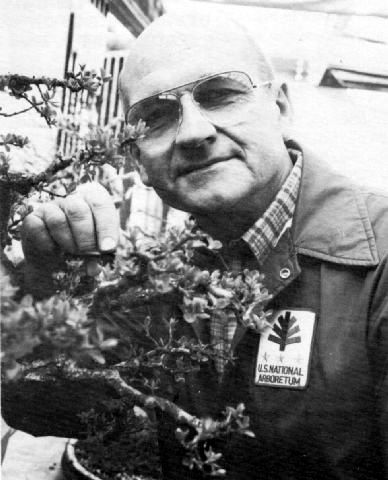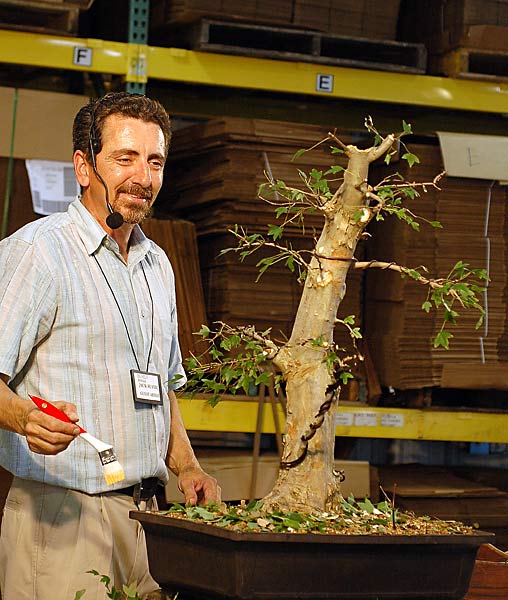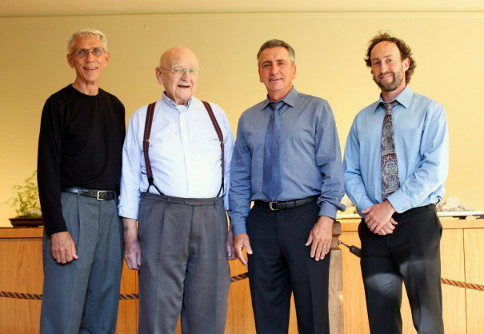| 1 |
1889 - Norio (Toshio) Kobayashi was born in the mountainous
Nagano Prefecture, west of
Tokyo. [While working as a journalist for the
Miyako Shimbun (after 1942,
as the Tokyo Shimbun), he
would edit (c.1921/1924?) and publish the very influential periodical Bonsai published by the
Great Japan Bonsai Promotion Society. Kobayashi would be an organizer of the Meiji-Taisho
Memorial National Bonsai Exhibition of Notable Trees held at the newly constructed Asahi Newspaper
Hall in Yurakucho, in central Tokyo (1927-1933). He would be a lecturer at the Tokyo College
of Gardening. In 1930 he would write The Study of Bonsai, and six years later would
also have published Contemporary Bonsai and their Care and Study and cultivation of
Satsuki azaleas, all in Japanese. He would be one of the founders and major executives
of the Kokufu Bonsai Association, a private organization which would hold an annual
exhibition. Emphasizing creative bonsai at the Tokyo
Metropolitan Art Museum in Ueno Park, these began in the Spring of 1934 and initially had two shows
a year. In 1951 the Japanese Travel Bureau in its Tourist Library series would publish his
Bonsai -- Miniature Potted Trees in English. Nine editions of this highly respected
book by this acknowledged authority would see print by the end of that decade alone, quickly finding
its way to the West and enlightening the bonsai students there. One of its readers was the
up-and-coming California teacher John Naka, who would begin exchanging letters
with Kobayashi in 1963. That November, acclaimed for his success in helping to bring bonsai up to
the level of a cultural art, Kobayashi would be granted a
Medal of Honor with a Yellow Ribbon by
the Japanese government. He would invite Naka to visit the Kokufu-ten, and the latter would do so in
early 1965. While there, Kobayashi would meet with Naka several times and introduce the American
to leading figures in the world of Japanese bonsai. He also would encourage Naka to use
American plants as bonsai material and not rely on the plants traditionally used in Japan for dwarf
potted trees. Kobayashi would retire in 1967 from editing and publishing the periodical Bonsai
after 518 consecutive issues. He would die in 1972 at the age of 83.]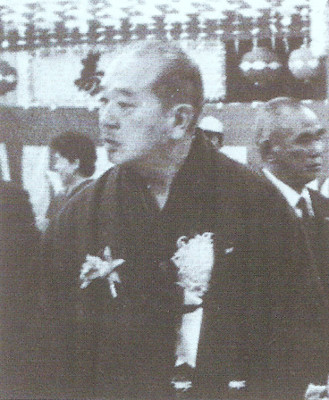
"Toshio Kobayashi"
(Personal e-mail from Yukio Murata to RJB Apr. 22, 2006;
Kobayashi, Bonsai -- MPT, 14th printing, 1966, Editor's Notes, pp. 5-6,
24-25; Connie Rosade's column in Bonsai Journal, ABS, Vol. 2, No. 1, pg. 17; per William N. Valavanis
e-mail to RJB 27 May 2014, "Please note the error that they misread Norio Kobayashi's name as Toshio Kobayashi."
Bill graciously sent me this booklet which he had picked up on his recent trip to Japan;
Meiji-Taisho Memorial National Bonsai Exhibition of Notable
Trees album, seen February 22, 2025) SEE ALSO: Feb 23, Dec 12
(The Story of "Bonsai", The Omiya Bonsai Art Museum, Saitama, March 21, 2014, pg. 20) 1907 - Kenneth Iwatoki Sugimoto was born in Hiroshima, Japan. [At an early age he would learn bonsai from an old master who lived near him. In 1915, Ken would come to these shores, his family already in the U.S. He would continue to develop his art under the tutorship of renowned bonsai master Professor Sakakibara (who was on a leave from Japan) and would establish in 1939 the West Los Angeles Bonsai Club. He would serve briefly as Instructor and President until the war. After the internment years, Ken would settle with his family in Lodi. In 1951 he would open the first retail bonsai nursery in this country a little ways to the west in Palo Alto. Two years later in the Spring Ken would found and be the president of the Peninsula Bonsai Club there, now the oldest bonsai club in the United States. Ken would be considered instrumental in establishing the Bonsai movement in America, also helping form the San Francisco Bonsai Club and being the instructor for both the Milbrae Adult School Bonsai Club and the Stockton Bonsai Club. He would lead trips to Japan in 1968 and 1971. Specializing in the formations of trees in rock plantings, Ken's creative techniques would attract bonsai masters from Japan who'd come to learn this method from Ken. He would teach and run Ken's Bonsai Nursery for many years, before retiring and having his oldest son Tak take over the business. Still teaching as late as 1997, Ken then would die of natural causes on Jan. 19, 2001 in Palo Alto. Kinuyo, his wife of over 70 years and also born in 1907, would be living in a rest home for at least four years after that. The club would hold an annual show every Mother's Day, skipping only 2001 in memory of Ken.] 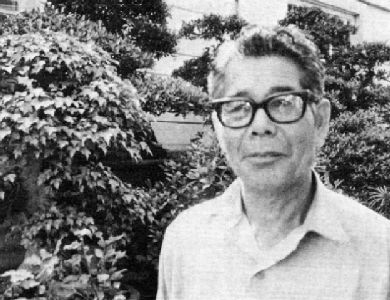
Ken Sugimoto
(RJB phone call to Tak Sugimoto on Aug. 16, 2005; "About Ken's Bonsai Garden,"
http://www.kensbonsai.com/about.html
; Traugott, Elisabeth "Life on a small scale,"
http://www.paloaltoonline.com/weekly/morgue/real_estate/1997_Jan_24.HOME24.html
; obituary, Palo Alto Weekly, Jan. 31, 2001,
http://www.paloaltoonline.com/weekly/morgue/community_pulse/2001_Jan_31.OBITLE31.html
; "Peninsula Bonsai Club Show,"
http://www.bonsaitalk.com/forum/printthread.php?t=6460
; Dillon, J.A. "Sokumenzu - Profile,"Bonsai Magazine,
BCI, Vol. XI, No. 4, May 1972, pg. 20, which also states "He is American born, reared and educated in Japan
thru six years of Elementary School and a year and a half of High School, in Iwakuni on the main island of
Japan. Then in Hiroshima he specialized in Business Education at the High School there. Ken first
studied Bonsai at an early age in the Iwakuni Bonsai School where he was an honor student. Lodi,
California was his next home for eleven years; but Bonsai called again taking Ken to Los Angeles...")
SEE ALSO: Jan 19
(Bonsai Magazine, BCI, May 1972, pg. 20) 1945 -- Mário Alberto Garcia Leal was born in Batatais, SP, Brazil. [He would go on to be one of the main popularizers of bonsai and penjing in Brazil.] (Facebookpage, https://www.facebook.com/Mario.A.G.Leal/about_places) SEE ALSO: May 29 1975 -- Robert F. Drechsler became the first curator of the National Bonsai and Penjing Museum at the U.S. National Arboretum in Washington, D.C. with the arrival to the U.S. of the Japanese Bicentennial bonsai. One of the senior technicians, Bob was a well-trained horticulturist who, it so happened, had been caring for the small collection of penjing that had been presented to President Richard Nixon during his February 1972 visit to China. [Bob would continue in the curator's position until his retirement in 1996. Warren Hill would be the second curator from 1996-2001; Jack Sustic third from 2002-2005; Jim Hughes fourth from late 2005 to late 2008, when Jack would return to the position until late 2016; Michael James would be named assistant curator that October and then become curator in mid-2018.]
1978 -- The Penjing Garden at the Shanghai Botanic Garden opened to the public on 4 hectares of land. "Shanghai Style Penjing" is one of the important artistic Penjing schools in present-day China. The essential collection here has more than one thousand pots of Tree Penjing on display. Most of these are prized and have won wide commands in exhibitions at home and abroad. Thirty pots of Rock Penjing represent the spectacular landscapes of China. Many visitors are fond of the Penjing Garden, and important noble guests from home and abroad are always received here. (Shanghai Botanic Gardens, subgardens open to the public, http://sinosource.com/SH/PUB/SHBG/subgardn.htm.) |
||||||
| 2 |
1948 -- Kunio Kobayashi was born. [He would grow up in a family that was
involved in the potted plant business, providing cyclamen and other plants for market and wholesale, and had
attended a gardening high school in eastern Tokyo, which has traditionally
been a horticultural area serving the capital city. One winter morning Kobayashi would take the day off from work and go visit
the Daimaru Museum. There he would have a revelation when he saw his first true bonsai on display at the
Sakafu Ten, the Japanese Professional Bonsai exhibition, near Tokyo Station. He would then start working as a bonsai artist in 1976
when he was 28. At the time there would be a boom in interest in bonsai which he would be able to tap into, developing
thousands of cuttings that would sell very quickly. The money he'd make would then be invested in much older trees.
In 1983 he would take the first prize himself at Sakufu Ten. In 1999 he would have won the grand prize, the Prime Minister's Award,
an unprecedented three times. And in October of the following year he would beat his own record with a fourth award. He would
be a celebrated artist in Japan and throughout the world.
In 2002 he would open the Shunka-en Museum in Eastern Tokyo's Edogawa City with "the ambition to spread Japanese culture, especially
bonsai, in a new way to the rest of the world." Designed in a very Japanese style, the museum would have sixteen individual rooms
of tatami mat floors and bonsai displayed in tokonoma. Three tea-ceremony rooms would have hearths and look out over the gravel
garden and bonsai creations. Apprentices would train there,
and over the years thousands of strolling visitors would gain a greater understanding and wonder for a cultural
heritage that would become synonymous with Japan. A report of a 2016
visit to Shunka-En can be found here. In March 2024 WABI Channel presented a fascinating two-part video conversation
of Kunio Kobayashi and Masahiko Kimura, here and
here.]
("Kunio Kobayashi, HookedOnBonsai.com, 2023;
"Mr. Kunio Kobayashi Collection," http://www.j-bonsai.com/koba_colle.html;
Shizuka, Saeki "Bonsai Universe," Culture Feature, Look Japan, January 2001, accessed 09/28/01,
http://www.lookjapan.com/LBsc/01JanCul.htm;
Ryall, Julian "Bonsai Branching Out,"
http://www3.gov-online.go.jp/pdf/hlj_ar/vol_0021e/28-30.pdf)
2009 -- Weyerhaeuser Company, engaged primarily in the production of timber, wood, cellulose and homes, was heavily affected by the weakness in housing and construction industries resulting from the economic recession from Autumn 2008 on. Therefore, as of this date, Weyerhaeuser's Pacific Rim Bonsai Collection in Federal Way, Washington was closed indefinitely to the public. (The trees would remain intact and be well-maintained so that the Collection could be re-opened at some future date. SEE this announcement. The Collection would re-open at a basic-services level -- no money was being spent on extra lectures, advertising, or off-site displays -- in June 2010.) ("From the Curator," http://www.weyerhaeuser.com/Company/Bonsai/FromTheCurator; "The Pacific Rim Bonsai Collection" posting by Victrinia Ridgeway 16 June 2010 to Internet Bonsai Club Forum, http://ibonsaiclub.forumotion.com/bonsai-f1/the-pacific-rim-bonsai-collection-t3320.htm#33060.) SEE ALSO: Jan 26, Mar 8, Oct 7, Dec Also 2015 -- Sharon M. Muth, a lifetime member of the Puget Sound Bonsai Association, passed away at age 76 after a long battle with cancer. (When son John was 9 years old, his mother Sharon had trouble finding pots for her bonsai, and began creating and selling pots in their garage. Ten years later, Bonsai Northwest was started by Sharon Muth in 1985 when she made and sold bonsai pots to local club members. That year she participated in a panel discussion as part of the American Bonsai Society's convention in East Lansing, MI. Gradually she expanded her business into finished trees and starter lessons. In 1998 Sharon was one of the demonstrators along with Roy Nagatoshi and Qingquan Zhao at the Pacific Northwest Bonsai Association's 10th Convention in Seattle. In 2000 two big changes occured: Bonsai Northwest started importing Japanese pots and son John joined the business. John pioneered importing trees and at the same time greatly expanded their pottery with numerous trips to China and Korea to line up reliable suppliers. John has climbed mountains collecting trees in the Northwest, and has traveled across the country sharing his knowledge. Another big change occured in 2003 when they moved into their present location in the South Seattle area in Tukwila in King County, about 2.5 miles from Seattle-Tacoma International Airport. The time since then has seen many changes: regrading, wall building, greenhouse expansion, the addition of a koi pond with waterfall, and a larger retail shop. Today they are one of the best and largest Bonsai sources in America. John has taken over the business, thus insuring continued service to customers and enthusiasts for many years. Sharon was on the Weyerhaeuser board of directors for the Pacific Rim Collection.) (Facebook posting by Boon Manakitivipart on April 6, 2015; "About Us," http://www.bonsainw.com/about.php; "PSBA'S FEATURED DEMONSTRATOR-FEBRUARY 24TH-," PBSA Newsletter, January/February, 2014, pg. 1; "The art of bonsai," posted by Colin Diltz, Nov 19, 2013, http://o.seattletimes.nwsource.com/html/picturethis/2022293529_theartofbonsai.html; "Pacific rim bonsai exhibit," http://www.koiphen.com/forums/showthread.php?93045-Pacific-rim-bonsai-exhibit&s=56aa80b073dd297d08b8c99d51a2747b.) SEE ALSO: Jan 27, Feb 19 |
||||||
| 3 |
1995 -- A commemorative postage stamp was issued by Monaco in honor of the
European Bonsai Congress which would be held there June 9-11.
SEE ALSO: Jan 23, Jan 29, Feb 3, Feb 16, Mar 1, Mar 27, Mar 31, Apr 6, Apr 18, May 6, May 29, Jun 16, Jul 20,
Aug 20, Aug 22, Sep 22, Oct 1, Oct 4, Dec 9.
2012 -- Considered the first Philippine bonsai master, Modesto C. Manglicmot, Jr. (more commonly known as "Sir Modi") passed away at the age of 79 in his home in Project 8, Quezon City, due to a complication brought about his diabetes - high blood pressure and kidney failure. A day prior to his death, though, he was still able to visit the University of Philippines Bonsai Garden and even hold a workshop for 2 interested students. [Many of Modesto's bonsai in the garden either died or were then taken away by his wife, who would die in 2014. They had no children. At the present, people believe that his spirit is still in the UP Bonsai Garden, through his scattered ashes in each of his bonsai. In September, in his home province there is an annual tree planting in his honor.] (Personal email to RJB by Ms. Corazon Ong of Manila, 09-18-19; The UP Bonsai Garden; Modesto Manglicmot) SEE ALSO: Sep 1 |
||||||
| 4 |
1962 -- On the same day his first grandson was born, teacher John Y. Naka collected a
California juniper (Juniperus californica carriere) in the high desert country. In honor of 1962
(the "Year of the Tiger"), the 33" (83.8 cm) tall tree would later be named Tora (Tiger). (The tree
is believed to be the longest trained of any California Juniper.) [In November, another California juniper
would be collected. At 32" (81 cm) in height, this would be named Ryu (Dragon) because there is a
mythical rivalry between a "Tora" and a "Ryu" to see who can strive to obtain something that only
one can possess.]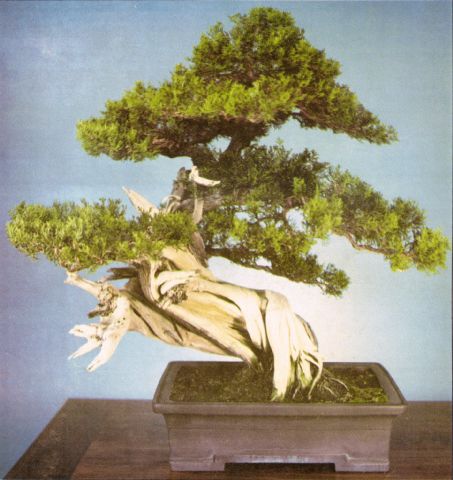
"Tora"
("About the Cover," Bonsai Journal, ABS, Vol. 19, No. 2, Summer, 1985, pg. 1; BT
by JYN, Color Plate 10 "Tora" photo taken in 1970, and 11 "Ryu" photo taken in 1973)
(Bonsai Journal, ABS, Summer 1985, front cover) 1970 -- Paul Matsusaki died in Phoenix, AZ five weeks before his sixty-fourth birthday while putting finishing touches on the local Bonsai Society's display. (Toyotoshi had been raised on the south side of the Japanese island of Shikoku, and had learned a few things about bonsai while watching both an older brother and grandfather. Working for a family in Seattle to be near his lumberman father, the fourteen year old boy was called Paul when his employer couldn't pronounce his given name. He later moved to Southern California where he grew various agricultural crops, actively promoted traditional Japanese culture, and met and married his wife, Edna Tani. They spent WWII in relocation camps in Arkansas and Arizona where they taught Japanese to both the young and adults and cared for the elderly. After the War, the couple and their daughter moved back to L.A., where Paul briefly farmed and tried his hand at landscaping. Relocating to Phoenix, they joined the Japanese community here and, having found his niche in landscaping, in the early 1950s Paul opened the Toyo ("Oriental") nursery at his house. Teaching bonsai to various students informally at his nursery, including a young landscaper named Leroy Fujii, Paul read about a rising teacher in California named John Naka. Invited, John came over and gave a workshop, and Paul and he became friends. Some of Paul's students insisted on establishing a formal club in Phoenix after John's visit. A club was officially founded in the fall of 1962 by twelve members and John was invited back annually to teach. Paul and club members, likewise, travelled each year to see John and his students at the California Bonsai Society conventions in the spring, and to discuss the art with regular attendees from back east such as E. Felton Jones and George F. Hull. For many years Paul also went over to L.A. to attend meetings of a group which preserved Japanese folk songs. In the spring of 1970, the lease had run out on Toyo Nursery and Paul was planning on relocating, after the Phoenix Bonsai Society show.) [The club's annual booklet would be first published as a tribute to Paul that Fall, and the following April saw a well-designed Japanese Memorial Garden established at the Desert Botanical Garden where the club met. When the club relocated its meetings to the Valley Garden Center in 1973, a smaller but more practical-in-the-desert Memorial Garden for Paul would be established there.] (Designing Dwarfs in the Desert by Robert J. Baran, Phoenix: Pyramid Dancer Publications, 1997, pp. 9-10, 12-13, 15-22, 27, 34, 37-40, 45, 49) SEE ALSO: Aug 19, Nov 1, Nov 15, Nov 21 1971 -- Fourteen enthusiasts established the Potomac Bonsai Association at an initial meeting held in the auditorium of the U.S. National Arboretum in Washington, D.C. James R. Newton was editor of the association's Newsletter, which was published for its members in the District of Columbia, Maryland, and northern Virginia. (Bonsai Journal, ABS, Summer 1971, p. 34) |
||||||
| 5 |
1941 -- Martin "Marty" Klein was born. [He would go on to be known as "The
Father of Side Scan Sonar."
He would be the Founder and former President of Klein Associates, Inc. (now Klein Marine Systems) of Salem, New
Hampshire. Klein Marine Systems, Inc. would be the world's leading supplier of
side scan sonar equipment and waterside security and
surveillance systems. This would all start when Marty graduated in the fall of 1962 from
MIT and soon find himself in
the middle of a historic event - the search for the U.S. submarine
Thresher, which had sunk in 8,400 feet
of water off the coast of New England in April 1963. There are certain events that shake the world, and in
the oceanography community this would be a huge moment. Everyone would want to find the Thresher, but
deep-water searching would be in its infancy. In 1960 Jacques Picard and Don Walsh would have traveled in the
bathyscaphe Trieste to the deepest part
of the ocean, so the Trieste would be brought in for the Thresher search. Marty would find
himself in charge of the team that would be assigned to build a side scan sonar for the Trieste. The
Thresher would eventually be found (but with a magnetometer and a towed sled), and participating in the
search would inspire Marty to improve existing technology with higher frequency and a narrower sonar beam in order
to get higher resolution pictures. Working at Edgerton, Germeshausen, and Grier (which later would become
EG&G), he would begin to develop a high resolution, towed,
side scan sonar. That would lead to the first commercially successful unit (in 1966) and on into a career
that would include everything from developing that technology's equipment and training customers to use it through
participating in exciting expeditions. In 1967,
Marty would set his own course in the new commercial field of Side Scan Sonar. He would found a company in
the basement of a little rented cottage in Lexington, MA on January 24, 1968. This would be a bold move since
the only companies involved in this area would be multi-million dollar organizations. Marty's systems would
be respected as the standard of excellence in the industry and would be deployed by governments, navies, port
authorities, surveyors, oil companies and universities worldwide. His sonar systems and derivatives would be
used around the world to locate, among other craft, the
Titanic (1985), the
Atocha (1985), wreckage of the U.S.
Space Shuttle Challenger
(1986), the Lake George
Radeau
(oldest warship in the U.S.) (1990), the Lusitania (1993),
TWA Flight 800 (1996),
Swiss Air Flight 111 (1998), John F. Kennedy Jr.'s
plane (1999), and
Egypt Air Flight 990 (1999),
Sir John Franklin's HMS Erebus (2014), myriad of
underwater antiquities, as well as performing the day-to-day work of hydrographic surveys. Marty would be a Life Member of the IEEE. He would be chosen as the New Hampshire Small Business Person of the Year in 1983. He would be a fellow of the Explorers Club and the Marine Technology Society, and would be the former Director of Budget and Finance for the latter. He would be elected to the National Academy of Engineering "for the development of underwater imaging systems that have contributed to ocean exploration and the recovery of high value objects." He would be on the Advisory Board of the MIT Sea Grant Program and the Stellwagen Bank National Marine Sanctuary, and be on the Collections Committee of the MIT Museum. He would serve as a judge and mentor for the Marine Advanced Technology Education (MATE) ROV Competition and a judge at the Massachusetts State Science Fair. He would have many publications and patents and receive many other awards and recognition for his pioneering work in sonar and ocean exploration. For as long as he could remember, especially when he lived in Boston and Cambridge, Marty would seek refuge at the Arnold Arboretum of Harvard University in Jamaica Plain, just southwest of Boston. He would be especially fascinated by the Larz Anderson Bonsai Collection, the oldest bonsai display in the United States. Inspired by this collection and by the bonsai displays at the New England Flower Show, Marty would begin to dabble with bonsai in the 1970s. He would be a director of the American Bonsai Society from 1987 thru 1993, its vice-president from 1993 to 1995, and its president from 1995 to 1997. Having met, visited with and tried to learn from many great bonsai masters, he would feel that he had reached the level of Advanced Beginner. On December 9, 2015, ten new bonsai would join the celebrated collection of dwarfed potted plants at Arnold Arboretum, including an Austrian pine (Pinus nigra) "forest," a style never previously grown in this collection. Part of a generous donation by Marty, the new acquisitions would enhance the horticultural value of the collection and provide unique opportunities for visitors to explore this ancient art form. On January 4, 2016, Klein Associates, Inc. of Salem, New Hampshire would be purchased by Mitcham Industries. (This would be the third time the company was sold. The first buyer would be OYO in 1989 and then L-3/com would do so in 2000.) On Sunday, May 22, 2016, at the Arnold Arboretum there would be a two-hour program "Collections up Close, the Bonsai and Penjing Collection." At this meeting Steven Schneider, Director of Operations, would introduce the new Martin Klein Collection, a comprehensive assemblage of Japanese, Chinese and North American species. Marty would be honored and humbled to contribute to this oldest collection of bonsai in the United States. More information on Marty can be found at www.martinklein.com. RJB's brief connection with Marty would begin in May 1999 when I'd meet him at the ABS Convention in Tucson, AZ and tell him about the first-draft of a bonsai coloring book. He would provide input for what eventually would become The Bonsai Coloring Book (2005). I would also have lunch with Marty (and John Romano, among others) in May 2002 at the International Scholarly Symposium on Bonsai and Viewing Stones in Washington, D.C. See also this Marine Technology TV interviews Marty Klein, the father of side scan sonar from April 2018. 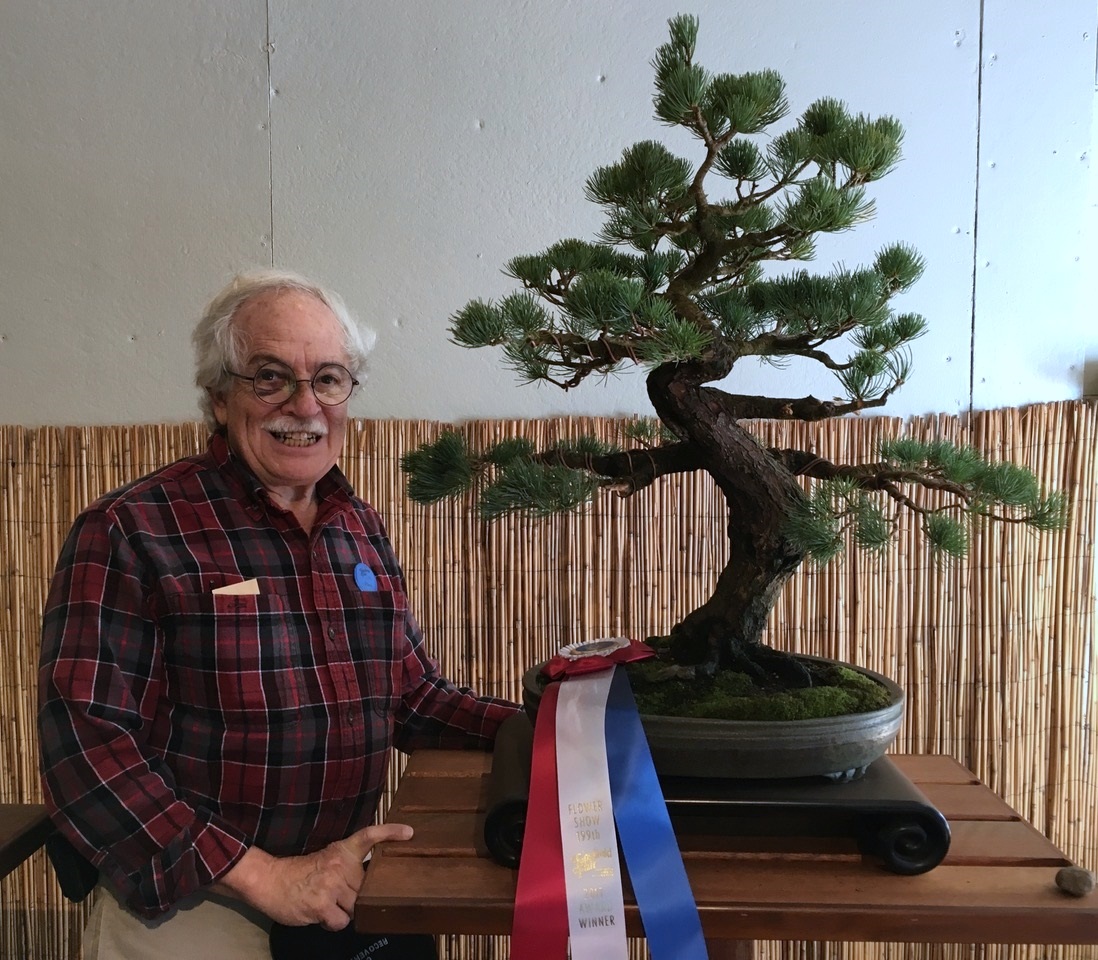
Marty Klein and a Japanese white pine that he started in a workshop with Joe Harris c. 1989. The workshop was supposed to be with the zuisho variety -- dwarf with very small and thin green needles -- but these were not available. Ten years after the workshop Joe saw the pine and he said "I can't believe you have kept this alive so long." This tree, unfortunately, died in the Spring of 2019 for unknown reasons. (2017 photo courtesy Marty Klein to RJB 10/21/19) (draft review of this biography by Marty in emails to RJB 10/11 and 10/23/19; "About," Klein Marine Systems; "In The Spotlight - Martin Klein, Side Scan Sonar Pioneer," Ocean Careers.com; assorted pages from http://www.martinklein.com/home/index.html; Schneider, Stephen "Sensei: An Austrian Pine Forest Bonsai Comes to the Arboretum," Arnoldia, Arnold Arboretum; "Annual Report 2015," Arnold Arboretum, pg. 12; The Indices 2004 ABS; also, ABS Journal 26(4):13 ['92]) |
||||||
| 6 |
1958 -- The Fresno Bee
published a story about Melvin Durao,
titled "Art of Bonsai is Antidote for Strain." Six years earlier
the 30 year old had moved across the Pacific Ocean from Honolulu, HA to
inland California. Durao started making rounds of local
nurseries. An "old Japanese fellow" told him a major secret of
bonsai: go to a nursery and ask to see the junk pile, the twisted,
gnarled specimens off somewhere in a forgotten corner. Durao
began making acqauintances with a loose-knit group of plant lovers,
gardeners and people who were learning bonsai. A handful of them
met informally, and these small gatherings eventually led to a
something which became the Bonsai Club of Fresno. The Club's
first mention was in this article. At the time Durao had a
collection of 55 trees. [Soon after, he would leave the club
seeing an influx of nursery owners and continuing to prefer the
quieter, less formal gatherings that preceded the club's
founding. He would continue to give demonstrations in Valley
towns, exhibit parts of his collection every year at the Fresno County
Fair, and eventually judge the fair's bonsai exhibit. Meanwhile,
there were about 30 members in the club and they were on sound
footing. Early in the 1960s, the Bonsai Club of Fresno would take the
new name of Fresno Bonsai Society. It would be one of two
organizations in the town, the other being Akatsuki, which consisted
primarily of Japanese-Americans.]
(Wasserman, Jim "FBS History,"
http://www.gsbf-bonsai.org/fresnobonsai/bonsai/fresnobonsai/fresno_bonsai_society1.htm
) SEE ALSO: Mar Also.
1989 -- With "World Peace Through Bonsai" as its theme, the four day long World Bonsai Convention opened in Omiya, Japan and the World Bonsai Friendship Federation was inaugurated and commenced corporate existence. A commemorative postage stamp was issued by Japan. ("World Bonsai Friendship Federation Update" by Ted. T. Tsukiyama, Bonsai Magazine, BCI, Nov/Dec 1989, pg. 10) SEE ALSO: Jan 23, Jan 29, Feb 3, Feb 16, Mar 1, Mar 27, Mar 31, Apr 3, Apr 18, May 6, May 29, Jun 16, Jul 20, Aug 20, Aug 22, Sep 22, Oct 1, Oct 4, Dec 9. 1993 -- The National Bonsai Collection was officially opened at the Birmingham Botanical Gardens, U.K. by Japanese Consul-General Mr. Ryaichiro Yamazaki. (The few bonsai societies in Great Britain established in the 1960's and 70's had increased significantly in number, with the growing interest in bonsai resulting in the setting up of the Federation of British Bonsai Societies which, in turn, helped establish this, the National Bonsai Collection in 1991.) ("The National Collection," http://www.nationalbonsaicollection.org ) |
||||||
| 7 |
1987 -- Juzaburo "Jesse" Furuzawa died at age 83 in Berkeley, CA. [Born in 1904 in Kyushu, Japan,
he came with his family to the U.S. in 1920. A Japanese black pine (Pinus thunbergii), originally
was grown from seed in 1942 in a perforated tin can in the Topaz internment camp in Utah by Juzaburo
who had received the seeds from relatives in Japan. One seed did germinate and survive, carefully nurtured
until Juzaburo's release from the internment camp when he would start to shape the tree as a bonsai. Juzaburo went on to
become an important San Francisco Bay Area bonsai practitioner and teacher, and the Yamato Bonsai Kai's second sensei.
One of his former students and the club's third sensei since 1976, John Uchida purchased this Japanese Black Pine from Juzaburo
in 1981. [John would donate this bonsai to the Pacific Rim Bonsai Collection in 1990. On February 9, 2020, the Pine would be one of two trees stolen from the Collection, but three days later they'd both be mysteriously returned. The second tree, a Silverberry (Elaeagnus pungens), would have a few broken branches from the ordeal. Luckily the trees were dormant at the time, so their biological systems were largely at rest. News reports of the theft would reach the Furuzawa family. Three generations of the family would come to the Museum in 2021 to see the tree, which they had not known existed. The bonsai would be the centerpiece of the Pacific Bonsai Museum's special exhibition, "World War Bonsai: Remembrance & Resilience," running May 9 through October 2021. The tree would later be on loan for a week in late March 2023 at a Japanese garden in the Northwest Flower & Garden Show in Seattle.] ("Juzaburo Jesse Furuzawa, Find a Grave; "Furuzawa, Juzaburo," Densho Digital Repository; "The Furuzawa Pine," Pacific Bonsai Museum; Molina, Emily "Pacific Bonsai Museum Featured in New Max Documentary," South Sound, Dec. 13, 2023; Sullivan, Olivia "One year later: Pacific Bonsai Museum heals from 2020 bonsai burglary," Federal Way Mirror, February 13, 2021; Weinberger, Hannah "The safe return of two bonsai trees restores a piece of Japanese American history," Cascade PBS, Feb. 13, 2020; Sailor, Craig "Gardens built around fish and forest fire recovery are themes at annual NW flower show," The News Tribune, March 24, 203) SEE ALSO: Sep 25, Nov 4 |
||||||
| 8 |
1890 -- Fusaji ("Frank") B. Nagata was born in Sho, Mizokunchi,
Tottori-ken, Japan. [At age 16 he would
come to the U.S., never having seen a bonsai in Japan. He arrived in San Francisco amidst the devastation of
the 1906 earthquake and fire. He
and Fumiko Kadowaki would be wed on February 14, 1924 after he moved to Los Angeles. In the 1920s long-time
gardener Frank and a friend, Morihei Furuya, would hear about one of the only people in the Los Angeles area who
knew how to make bonsai, Sam (Tameichi) Doi. They would go to see the little trees and be so fascinated
that they would persuade Doi to start teaching them the art form. Then would come the great war and the
relocation of all Japanese on the West Coast to camps in the interior.
No personal possessions could be taken that could not be carried. Frank
would have an American friend who'd let him plant his bonsai in his yard, with the promise that he would care
for them until Frank could reclaim them. Obviously, although his bonsai-uneducated friend had good
intentions, the trees would revert to their natural state and outgrew their bonsai status. The three of
them -- Nagata, Furuya, and Doi -- would happen to be assigned to the same relocation camp in April 1942 -- Amache,
near the town of Granada in eastern Colorado. Amache would be the smallest camp with only an 8,000 person
capacity. While there, the three would manage to put on a makeshift bonsai exhibit for their fellow
internees. As everything would be makeshift, including the trees, Frank would contact his American friend
and have some of his trees and pots sent to Colorado for the occasion. After the war the three men and their
families would return to Los Angeles. [Now, Mrs. Ai Okumura would also be a student of Doi. When John Naka would hear of Doi in a local barber shop, the young man would search out the teacher. (Doi would return to Japan in 1948, the following year.) Joseph Yamashiro and his wife would meet the Nakas in Colorado during the war -- they were all living outside the military boundaries of the internment requirement -- and would just happen to move next to them in California. The five would become close, spending all their time talking about and working with bonsai. In November of 1950, Mssrs. Nagata, Furuya, and Naka, along with Okumura and Yamashiro, would decide to show their trees at the San Gabriel Valley Fall Flower and Garden Show at the Fannie E. Morrison Horticulture Center in Pasadena. When they would arrive they'd be informed that individuals could not display unless they were sponsored by a club. Without a moment's hesitation, the quick-thinking Frank Nagata would speak up and say they were a club. And what was the name of the club? Again, without hesitation or benefit of conference: The Southern California Bonsai Club. They would now be allowed to enter their trees, which would win a trophy and a blue ribbon at the Show the next day. To celebrate the clubs' establishment, a demonstration would be given by the group's youngest member, John. (Within two years, he would be teaching, first his immediate friends, and then others.) [Frank would begin corresponding with masters in Japan and would become the first distributor of bonsai materials, information, and tools from Japan. In 1954, Frank would retire from gardening and open his bonsai nursery on Jefferson Avenue in West Los Angeles, the Alpine Baiko-En (Fragrance of Ume Blossom Garden), the first dedicated exclusively to bonsai. The same year he would start teaching classes every week without charge to his students. One of Frank's recommendations would be to read the new book (1951) by someone who would become a long-standing friend, Japanese author and publisher Norio Kobayashi's Bonsai, Miniature Potted Trees. Over the years Frank would continue to feel that this was one of the best books ever written on the subject and believed that it would be greatly appreciated and enjoyed by those who were searching for the "heart of the matter." Frank would say his classes were quite popular because he never charged anything. (Anyone knowing Frank would agree that this was true to his character, for he would be one of the most generous persons alive. Years later, on his birthday, when the members of his own club, The Baiko-en Kenkyukai, would assemble to pay him homage, he would give everyone a present. Frank would be proud that some of his very first students were still with him, such as Joe Loch, Margaret Guinney, and Earl Donovan. Donovan would later relate the following story: "'How much is it?' "'I thought you wanted to see the tree,' Mr. Nagata said. "I can still hear the sound of hurt in his voice. And I am still learning that lesson." [In 1957 Frank would start to import Japanese trees. His first love would be Satsuki azaleas, and he imported several beautiful specimens. Also in the imports would be Cotoneasters, Zelkovas, Shimpaku, and Pomegranates. Now, Khan Komai, heir to the Rafu Shimpu, the leading bilingual apanese-American daily newspaper in L.A., would have been seeing Kay Nagata, Frank's adopted daughter. The two would marry and Khan would study under his famous father-in-law, spending considerable time in nurseries after WWII, chauffeuring Frank in the latter's search for bonsai material. As time went on, Komai would acquire an eye that could judge good bonsai work, and he'd be frequently critical of what he saw. As a Father's Day present in 1958, Komai's wife Kay would give him two pots and two trees. "You've been awfully critical of others lately," she'd say. "Let's see what you can do." He would answer the challenge by opening his own nursery and teaching the art to his customers. [In April 1958, the Southern California Bonsai Society, hoping to make itself a state-wide organization, would be renamed The California Bonsai Society. John would be its president for thirty-two years, except for 1959 and 1960 when co-founder Morihei Furuya would helm the club. Frank would supervise the annual show in 1960, "Early Spring Bonsai." By this time the annual show would be recognized as the largest such exhibit in the United States. Earl Donovan would chair the 1961 show themed "Bonsai -- A Living Art." [Frank and his trees would figure prominently in Woodward Radcliffe's 1961 Bonsai booklet, with Nagata and Tsunji Yamashiro noted as "Technical Credit." A California juniper styled by him would be on the cover of ABS Bonsai Journal, 1968, Vol. 2, No. 2, sepia photograph courtesy of Mr. Naka. [The only time Frank would be late to a bonsai meeting at the Baiko-en Kenkyukai would be when the Los Angeles Dodgers were playing. [In 1968 the Nagatas retired to Temple City where Frank continued his bonsai interest and influence. Every year since about 1978, Frank's old students, the Caucasians that he taught at his nursery, and some of his new devotees, would sponsor a show in January at the Los Angeles County Arboretum. The title of the show would be "Winter Silhouettes," an idea originally introduced by Khan. This show would offer bonsai enthusiasts a chance to see bare deciduous as well as early blooming Quince, Ume, and some early blooming azaleas. After Frank's death in January 1980, the show would be continued as a memorial to the Dean of Southern California bonsaimen.] 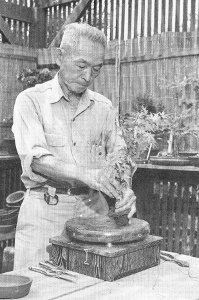
"Frank Nagata who has grown Bonsai for 40 years has dwarfed trees that are 100, 200 and 300 years old... Here he prunes roots and branches and manipulates a Japanese maple into Bonsai lines." (Woodward Radcliffe Bonsai booklet, Jersey City, NJ: T.F.H. Books; 1961, pg. 24) 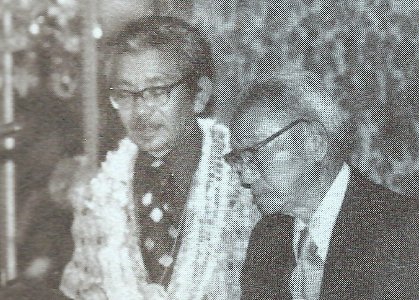
"A respected and much beloved pioneer of bonsai, Frank Nagata, is presented by Mr. Naka. Mr. Nagata, a co-founder of CBS, has taught bonsai for over twenty five years." (International Bonsai Digest Presents Bonsai Gems, Fall 1974, pg. 89) (Young, Dorothy S. "History of Bonsai West," International Bonsai Digest Presents Bonsai Gems, Fall 1974, pp. 93-94, Donovan, Earl "The Cost Factor," Bonsai in California, 1975, Vol. 9, pg. 43; Loch, Joe "Frank Nagata...His Wonderful World of Bonsai," Bonsai Magazine, BCI, Vol. IX, April 1970, pg. 6; Naka, John Yoshio Bonsai Techniques (Santa Monica, CA: published for the Bonsai Institute of California by Dennis-Landman; 1973, 1975, 1976, 1980, 1982, 1984, 1987, 1989, 1991. Tenth printing), pg. 257; Bonsai in California, No. 1 (1967), pg. 1; International Bonsai, IBC, 1986/No. 2, pg. 12; International Bonsai Digest Presents Bonsai Gems, Fall 1974, edited by Juyne M. Tayson, M.D., Earl H. Donovan, Associate Editor, pg. 90 with two b&w photos of Frank, and pg. 41 mentions that Donovan was the current president of Baikoen Kenkyukai; Bonsai Magazine, BCI, July/August 1983, pg. 205; Maine, Michael L. "Khan & Kay Komai," Garden Ideas and Outdoor Living, Spring 1989, pg. 60; Land, Dorothy "Celebrating 35 Years of Progress," Bonsai Magazine, BCI, Vol. XXXII, No. 4, July/August 1993, pg. 28; Bonsai Journal, ABS, Winter 1990, pg. 17; Place, Dorothy M. "Winter Silhouettes Bonsai Exhibition," Golden Statements, GSBF, Vol. XXXII, No. 2, March/April 2009, pp. 15-16; "Persons born 08 April 1890 in the Social Security Death Master File," http://ssdmf.info/by_birthdate/18900408.html; "Frank Fusaji Nagata, 1890-1980 (Founder of Baikoen Bonsai Kenkyukai),") SEE ALSO: Jan 7, Jan 10, Apr 1, Jun 19, Jul 4, Sep 9 2001 -- Bernard Coetzee, one of South Africa's pioneering and leading bonsai artists and mentor to generations of bonsai growers died. (He had been one of Becky Lucas' students in the Bonsai Society of South Africa Cape Town (esp. 1960). In the Autumn of 1970, Bernard, his new student Rudi Adam, and Gail and Lionel Theron were among the founders of the Cape Bonsai Kai. Other clubs had been established since the mid-1960s -- Transvaal (1965), Eastern Province and Pretoria (1969), Eastern (1972) -- and a need was soon felt for an overarching body that could promote interaction between clubs at a national level. As a result, the South African Bonsai Association was formed in 1975. Bernard Coetzee of CBK was instrumental in conceiving and establishing SABA as an entity, and he envisioned that SABA would be responsible primarily for organising national events, thereby embracing a strong bonsai fraternity in the country. Ultimately, however, SABA's objective would be to propose standards for bonsai growing and to promote judging criteria for trees. (In the mid 1970's, Bernard was helping at a bonsai show being held at Kirstenbosch Botanical Gardens. He suddenly noticed a small fountain of sawdust flying out of the front of one of the trees on display. Upon closer inspection he saw a small hole at the end of which there must have been a very busy borer that was creating a little pile of dust at the base of the tree. Ever diligent, Bernard went to his tool box, pulled out a syringe with hyperdermic needle, filled it with insecticide and proceeded to march up to the tree, stick the needle into the hole and give the bug a squirt of death. A visitor was then heard to say to her friend "See that's how they do it [i.e., dwarf the trees]!" (In 1985, Bernard decided with Des Slate to start a new club in Plumstead in the southwest area of the Western Cape. The club was named Oyama Bonsai Kai, literally "Big Mountain Bonsai Club." The club held its first exhibition at Kirstenbosch in 1986 and has never looked back. It has been a leading innovator in national bonsai ever since its inception producing some of the leading figures in bonsai in SA. Whilst Des took on the responsibility for running the day-to-day club, Bernard focused more on teaching bonsai design. He was a proponent of "design without style," a process for designing trees around their good features and the tree would end up in a style rather than trying to force a tree into unnatural designs. Over the years the system of growing bonsai to a style ruined many trees that were forced in the style of the growers choice. Bernard realized that this was not the way to go about designing and led Oyama members to rather design the tree around good features, making more natural bonsai. This is a principle followed by a great many growers today and is taught at Oyama's Beginners Course.) (Dedication in Acknowledgements of "Bonsai in South Africa: Your Collection" by Carl Morrow, Veld & Flora, September 2001, pg. 133; "Bonsai at Oyama," Oyama Bonsai Kai; Fourie, Barry and Charles Cerono, "History of Bonsai in South Africa," Pretoria Bonsai Kai, Koeda, 2019 No. 5, pp. 14-18; "About Us," South Africa Bonsai association; "World's Funniest Bonsai Stories," includes post by Carl Morrow, 23 Aug, 1999) SEE ALSO: Jan 16, Jan 25, July 29, Aug 25 2005 -- Renowned Bangalore bonsai master, S. "Bonsai" Srinivas today launched a collection of branded bonsais, "Signature Bonsai." Srinivas created his first bonsai in 1960 after several years of experimentation. His family is said to have opposed his ideas and he is believed to have had no income from his bonsais for some eight years. Today, Bonsai Srinivas is a household name and a US-based private equity firm called The Gabriel Management Group (TGMG) recently acquired the business with the idea of taking it global. Each "Signature Bonsai" has his signature on the ceramic container that supports the miniature tree. The branded Bonsais will come also with an authenticity card, which contains tips on maintenance and nurturing Bonsai. Under the tie-up TGMG will market the Signature Bonsais in India and the US. Signature Bonsai is a collection of one to five-year-old plants of some 50-60 different species. The collection consists of two varieties: Standard collection, plants that can be in the same container for over 15 years and cost Rs 500; Starter collection, plants costing Rs 300 and need to be shifted to other containers in three years. Srinivas said that it is proposed to add fruit trees also to the collection of Signature Bonsais in the future. ("Potted plant maker ties up with US firm," The Hindu Business Line, April 8, 2005, http://www.blonnet.com/blnus/07081506.htm ; Sujit John "A yummy way to win business," Times of India, May 26, 2004, http://timesofindia.indiatimes.com/articleshow/700179.cms ) SEE ALSO: Aug 9. 2022 - Iconic bonsai artist and teacher Andrew Nicholas Lenz died at age 82. (Abel Lenz's April 14, 2022 FB posting of Memorial Notice.) SEE ALSO: Jan 19, Oct 26 |
||||||
| 9 |
1933 -- Robert "Bob" F. Drechsler was born in Washington, D.C. to Carl and Anna Agnes
Drechsler. [After his mother's death in 1935, he and his older siblings would be raised in the
German Orphan
Home. He would attend Anacostia High School where he'd be active in music, clubs, and the National
Honor Society, later graduating from the
University of Maryland
with a Bachelor of Arts in Floriculture. Bob would serve in the United States Army and play for the
Third Army Band as a
clarinetist. He would be honorably discharged in November 1962. [Bob would then join the U.S. National Arboretum as an agricultural technician in their plant breeding program. Affectionately known as "Bonsai Bob" in the bonsai community, in 1975 he would become the first curator of the National Bonsai & Penjing Museum at the U.S. National Arboretum, the first museum of its kind dedicated to the public display of the art of bonsai. He would also be a Past Grand Master of the Grand Lodge of the District of Columbia.] ("Robert 'Bob' Drechsler," Legacy.com) SEE ALSO: Feb Also, Apr 1, Apr 22, Oct 20. 1993 -- The Internet newsgroup rec.arts.bonsai was first posted by Mike Bartolone. (general e-mail dated 23 May 1996 from Hud Nordin announcing that the 25,000th article had been posted the day before. By 1996 this group would have given itself the name Internet Bonsai Club and would include the following participants among others -- from archival posting printouts which RJB kept of certain notable subjects -- Ron Anderson, Peter Aradi, Mike Bartolone, David M. Boland, Lynn Boyd, Chris Cochrane, Iris Cohen, Marco Favero, Dusty Griffiths, Herb L. Gustafson, Marty Haber, Geoline Havener, Craig J. Hunt, Shelly Hurd, Jim Jenigen, Michael Johnson, Marty Klein, Thomas Kunka, Jim Lewis, Mike M (aka alchmst), Anton Nijhuis, Hud Nordin, Gail O'Donnell, Nick Payne, Michael Persiano, John Powers, John Romano, Carl L. Rosner, Andy Rutledge, Nina Shishkoff, Jim Thomas (aka Da Youper), William N. Valavanis, Sandy Vrooman, Alan Walker, Andy Walsh, Brent Walston, and John Yasaki) SEE ALSO: Jan 26, Aug 3 1998 -- Barely six months after the 3rd World Bonsai Convention, Mr. Lee Chul-ho, the president of the Korean Bonsai Association, died from a heart attack. His death dealt a serious blow to the bonsai society in Korea. The group had hosted the WBFF Convention. In spite of an insufficient preparation period, Mr. Lee actively publicized Korea's first worldwide bonsai convention. Its success was achieved by the people in the Korean bonsai world, and they should be praised for their devotion to development and friendship. At the opening ceremony, Mr. Lee, the secretary of the Dept. of Forestry, gave his remarks to the 700 participants from 20 countries. Mr. Lee did his own demonstration at the convention, which also spotlighted 220 typical Korean bonsai on display. An exhibition on the history of bonsai in Korea was also enjoyed by enthusiasts from around the world. ("Success of the 3rd World Bonsai Convention," Asia-Pacific Region, World Bonsai Friendship Federation, http://www.bonsai-wbff.org/rasia.shtml, accessed 05/31/04.) 2007 -- Dr. Gunther Lind died after severe illness. (He had been a professor of physics education at the University of Kiel in Germany. His main fields of research were the history of physics teaching in Germany and empirical research on expertise, that is, comparing physics "experts" and "novices" according to cognitive aspects of learning and problem solving.) (The International Physics Olympiad (IPhO) is an international physics competition for secondary school students. The first such competition was organised by Prof. Czeslaw Scislowski in Warsaw, Poland in 1967. Since that time the International Physics Olympiads have been organised, with few exceptions, in a different country every year. The first IPhO organised by a non-socialist country was the XIII IPhO that took place in Malente, Federal Republic of Germany, in 1982. It was due to very efficient work done by Dr. Lind. Then, for the first time, the participants solved, under agreement of the International Board, two experimental problems in place of one, previously set. In 2001, the IPhO International Board accepted a new system of awarding the prizes. The new system, designed by Cyril Isenberg and Dr. Lind was based on relative number of contestants for each type of award, instead of the score boundaries defined by percentage of the best contestant's score. Dr. Lind wrote about the IPhO in Physikalische Olympiade-Aufgaben (Aulis Verlag Deubner & Co., Koeln; 1986). He also wrote the chapter "Chemistry in Physics Textbooks, 1780-1820" for Communicating Chemistry Textbooks and Their Audiences, 1789-1939, edited by Anders Lundgren & Bernadette Bensaude-Vincent in 1999.) (Dr. Lind turned to bonsai seriously only after retiring and had started a website on history and philosophy of bonsai within the German www.bonsai-fachforum.de. His main interest was in the stylistic aspects of bonsai. It took a very competent bonsai and art connoisseur to disclose a field of knowledge that is so largely unknown in the west.) [During the Meetings of the International Board during the XXXVIII International Physics Olympiad in Isfahan (Iran) July 13 - 2007 (with 69 countries in attendance), the President of the IPhO would inform the International Board that Prof. Gunter Lind (Germany) and Dr. Hans-Uno Bengtsson (Sweden), had passed away during the past year. The International Board would commemorate the two with a Minute of Silence.] (Notes at the end of Dr. Lind's article "Art and Kimura"; Gorzkowski, Waldemar "International Physics Oympiads (IPhO): Their History, Structure and Future," http://ipho2010.hfd.hr/tekst.php?id=8 ; "Asian Physics Olympiad," https://secure.wikimedia.org/wikipedia/en/wiki/Asian_Physics_Olympiad ; RJB corresponded with Dr. Lind Feb through June 2006 when the latter contacted me about the Gothaer Penjing Album (Canton, c.1800) and other portrayals. Per his last personal e-mail to me 05 Feb 2007, Dr. Lind stated that "In the last months I have serious difficulties with my health (stomach-cancer).") 2007 -- South Florida's reknowned bonsai pioneer and watercolorist, Joe Samuels, died at Baptist Hospital in Kendall, Florida after suffering a severe stroke. He was 87. He is considered the "father" of Ficus salicaria [more commonly seen in literature incorrectly as F. nerifolia] as a bonsai specimen. (Jim Wilkins took up interest in bonsai with Garland Faulkner in 1956. In 1957 Jim started his Jaboticaba seedling from Fairchild Tropical Garden and the following year began to work with Joe Samuels. Jim was a paraplegic and Joe did the physical work on the trees. As Superintendent of Parks for the City of Miami Beach, part of Joe's responsibility was buying landscape plants and trees. One of his favorite stops was the old Fantastic Gardens Nursery (once run by Bob and Catherine Wilson near 67th Ave. and 95th St. in South Miami, and closed sometime after 1981). On one such visit in 1965, he spotted a small tree ("finger thick") that looked like a strange Ficus. He questioned the owner who said he had "imported the fig from New Guinea" ... however, it was not for sale. Joe was a patient man and continued to ask about this new-found prize. After much "pleading and arm twisting," Joe finally was able to purchase the unusual fig in 1966. Joe "observed the growth pattern of figs in the landscape and planned accordingly, including aerial roots. I noticed that Ficus often have surface roots as far as 500 feet from the trunk. From this I found out they would grow in shallow containers." Joe said he always took "wisdom from trees in their natural environment." By 1972, the first aerial roots were ready for refinement. He first exhibited his banyan style fig at the Bonsai Clubs International convention in Miami Beach, FL in 1975. Participants from all over the world (including Japan) applauded it. Following the convention, Joe had a new vision for his Ficus bonsai. He placed it in a larger container, and let it grow. Meanwhile, he rooted cuttings "just in case anything happened to the original tree, the strain would keep going." He shared these cuttings with many of his bonsai friends. When exhibited again in 1985, the original bonsai, named "The Cloud," was a specimen tree. Today, many hobbyists claim to have a Ficus bonsai grown from a cutting of "Joe's tree." They probably do. Joe was often referred to as the Father of Bonsai in South Florida, and he served as the Bonsai Society of Miami's head of exhibits for club shows. Jim Wilkins had passed away in 1969; Garland Faulker would still be alive at the begining of 2011, 93 yrs. in Coral Gables. A great number of their early trees, including the Jaboticaba, are still in top shape and are being refined by Jim's son Gary.) 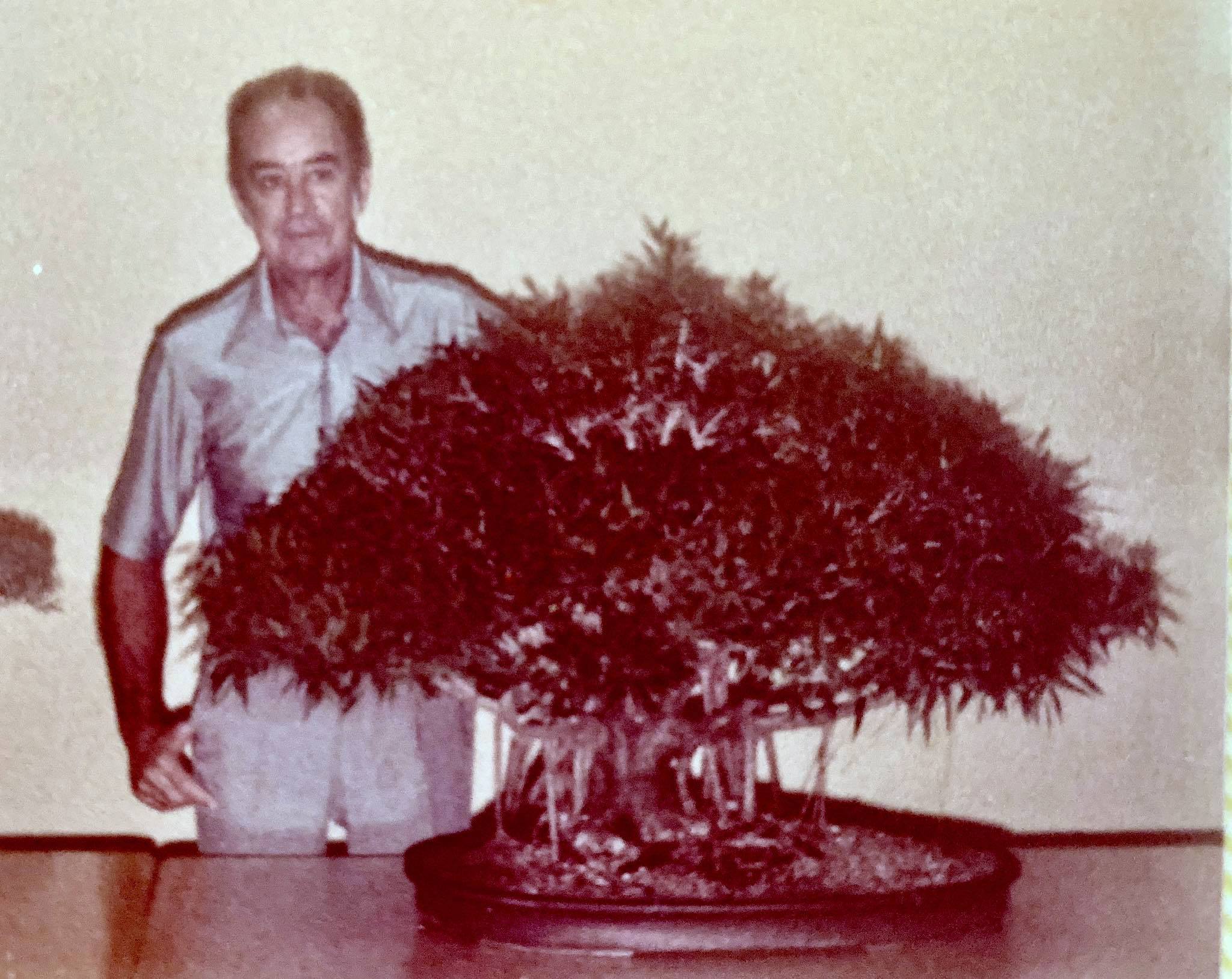
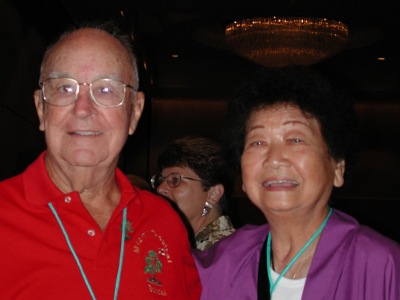
Joe Samuels and Kay Komai, 07/05/02, BCI Convention in Orlando, FL.
(Photo courtesy of Alan Walker, 05/11/07) (Please see this Tribute page, http://artofbonsai.org/galleries/samuels.php; post by Dustin Mann, 01 Jan, 2011, http://ibonsaiclub.forumotion.com/t5169-jim-smith-s-dura-stone-nursery#52384; story of the Ficus, http://www.bonsaimary.com/Ficus-bonsai.html, was brought corrected to RJB's attention in e-mail from Mary C. Miller, the story's author, prominent tropical bonsai teacher and Joe's long-time companion; Prince, Moyna "Nat DeLeon, a history," http://www.fcbs.org/articles/NatDeLeon-MoynaPrince.htm; Steig, Stacey "Mini Flora," http://www.miaminewtimes.com/calendar/mini-flora-6359068) SEE ALSO: Jul 14. |
||||||
| 10 |
1958 -- Gerald N. Rainville was born in Montréal, Québec, Canada.
[He would begin gardening as a child and, by ten years old, would decide upon a career in horticulture. By
the age of sixteen, Gerald would have spent several summers working in a local garden nursery in his native
city. With a friend, he also would run a small residential garden business. A summer spent visiting
gardens throughout Europe would crystallize his vision and Gerald would enroll at
Algonquin College, in Ottawa, in the Department of Horticulture, majoring in
landscape design. [During a school exchange program at the 1976 Montréal Olympics, Gerald would meet the then college student Hiroyoshi Yamaji, of Yamaji Sanshoen, Japan and be inspired to make bonsai his life's work. After graduating from Algonquin in 1979, he would board a two-day flight to begin a bonsai apprenticeship in Japan. He would be met by a group of bonsai growers from Takamatsu at Haneda Airport, whisked off to the bonsai professionals' exhibit Sakufuten, meet many bonsai dignitaries, and by that night, sit mesmerized on the high-speed Shinkansen heading to Shikoku. Gerald would spend several years with Hiro, and be fully accepted into his government-sponsored apprenticeship group the "Kokubunji Successor's Club of Bonsai". Kuniaki Hiramatsu of Hiramatsu Shunshoen was the group's Sensei in the Kokubunji area of West Takamatsu. Gerald would always be greatly indebted to him and all the bonsai growers, friends and teachers for the knowledge, discipline and skills he would acquire. He would revisit Kokubunji-cho many times to work and study for anywhere from one to six months at a time over the decades. [Gerald would be the first Canadian to have embarked on a long-term bonsai apprenticeship in Japan. Upon returning to Montréal, Gerald would found Shikoku Bonsai Canada in 1983 with Arthur Skolnik, would be his full-time apprentice for several years. Throughout his career, Gerard would remain committed to informing and training others in this art. [In 1986 he would move back to the Orient for another year of study. Upon his return to Canada he would establish a half hectare bonsai nursery in the outskirts of Vancouver, British Columbia and open Takamatsu Bonsai, a retail outlet in the downtown area. Weather would have almost everything to do with this decision as the climate is temperate compared to the rest of Canada, similar to Japan's and excellent for outdoor cultivation of evergreens. [In 1991 Gerald and his young family would decide to once again return to Japan. Shunmyo Masuno of Yokohama would accept Gerald as an apprentice in landscape architecture. The Rainville family would then relocate two years later to Roberts Creek located just west of Vancouver, where they would operate Shikoku Bonsai Canada, Nursery and Landscaping on the Sunshine Coast. The 1 hectare (almost 108,000 sq. ft.) bonsai nursery would be focused on long-term production of quality bonsai. There they would continue to explore the relationship between art and nature. By 2017 the nursery would have several thousand trees that were started and trained by Gerald, many dating back to the nineteen eighties. He would then have one full-time Western apprentice and would have had several young ones from Japan over the years. [Shikoku would also be a design/build firm offering services that addressed all aspects of planning, garden consulting and landscape construction services. Gerald would also offer lectures and slide shows on Japanese gardens and workshops on pruning, maintaining and constructing techniques. Jerry-san would return to Japan each autumn to help and continue to study under Kuniaki Hiramatsu and his son Koji for a month or two during the Kokubunji bonsai festival and Taikan-ten in Kyoto, the second largest bonsai exhibition in Japan.] (Private Facebook Messages to RJB from Gerald 05/07/17, 05/29/17, and 07/18/17; "Profile," Shikoku, http://www.shikoku.ca/profile.html;"Shikoku Bonsai," JGarden, http://www.jgarden.org/designers.asp?ID=111; "Gerard Rainville, Web References," Zoominfo, http://www.zoominfo.com/p/Gerald-Rainville/717848615; "Ahikoku Bonsai brings art of Japanese design to Roberts Creek," The Local Weekly, Nov. 20, 2013, http://www.thelocalweekly.ca/shikoku-bonsai-brings-art-of-japanese-design-to-roberts-creek/; "2016 Autumn Japan Bonsai Exploration -- Part 5," Valavanis Bonsai Blog, Nov. 19, 2016, https://valavanisbonsaiblog.com/page/4/?themes_on_signup_preview=1) SEE ALSO: Jan 27, Dec 23 1970 -- From this day through the 12th, the American Bonsai Society (ABS) Symposium was held in Dallas, TX. Speaker John Naka, from California and making his national debut, was well-received. [So well, in fact, that he was invited to the next year's event in July in Norfolk, VA. A photo-article "Magic With Naka" in the Spring 1970 issue of the Bonsai Journal (pg. 10) preserved the step-by-step transformation of a nursery-grown juniper; the Fall 1971 issue had both a cover photograph and illustrated story of "The Forest That Grew in Norfolk" (pp. 46-47). Eleven large nursery-grown junipers were transformed in the latter demonstration] ("Apologia to Our Readers," Bonsai Journal, ABS, Winter 1972, pg. 74) |
